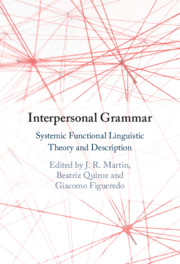Book contents
- Interpersonal Grammar
- Interpersonal Grammar
- Copyright page
- Contents
- Figures
- Tables
- Contributors
- 1 Introduction: Theory and Description in Interpersonal Grammar across Languages
- 2 Interpersonal Grammar in Spanish
- 3 Interpersonal Grammar in Khorchin Mongolian
- 4 Interpersonal Grammar in Mandarin
- 5 Interpersonal Grammar in Tagalog: Assessment Systems
- 6 Interpersonal Grammar of Pitjantjatjara
- 7 Interpersonal Grammar in Brazilian Portuguese
- 8 Interpersonal Grammar in British Sign Language
- 9 Interpersonal Grammar in Scottish Gaelic
- Index
- References
3 - Interpersonal Grammar in Khorchin Mongolian
Published online by Cambridge University Press: 21 May 2021
- Interpersonal Grammar
- Interpersonal Grammar
- Copyright page
- Contents
- Figures
- Tables
- Contributors
- 1 Introduction: Theory and Description in Interpersonal Grammar across Languages
- 2 Interpersonal Grammar in Spanish
- 3 Interpersonal Grammar in Khorchin Mongolian
- 4 Interpersonal Grammar in Mandarin
- 5 Interpersonal Grammar in Tagalog: Assessment Systems
- 6 Interpersonal Grammar of Pitjantjatjara
- 7 Interpersonal Grammar in Brazilian Portuguese
- 8 Interpersonal Grammar in British Sign Language
- 9 Interpersonal Grammar in Scottish Gaelic
- Index
- References
Summary
This chapter provides a description of the basic interpersonal clause system in Khorchin Mongolian – i.e., MOOD. The categories in the traditional description of Khorchin Mongolian clause grammar are mostly defined notionally and are not grammatically motivated. In contrast, the description in this chapter motivates the clause classes in the MOOD system in terms of their structural configurations based on unmonitored conversational data. The functions of Predicator, Positioner, Interrogator and Inquirer are used to distinguish the general types of [indicative] and [imperative] and the more delicate systems they make available. The MOOD systems are then characterised in relation to their functions in exchanges in terms of the structural configurations that realise options in NEGOTIATION in discourse semantics. The description in this chapter makes significant contributions to (i) the unified description of Khorchin Mongolian clause types and structures, and (ii) the characterisation of grammatical patterns in terms of discourse semantics.
- Type
- Chapter
- Information
- Interpersonal GrammarSystemic Functional Linguistic Theory and Description, pp. 64 - 95Publisher: Cambridge University PressPrint publication year: 2021
References
- 6
- Cited by

